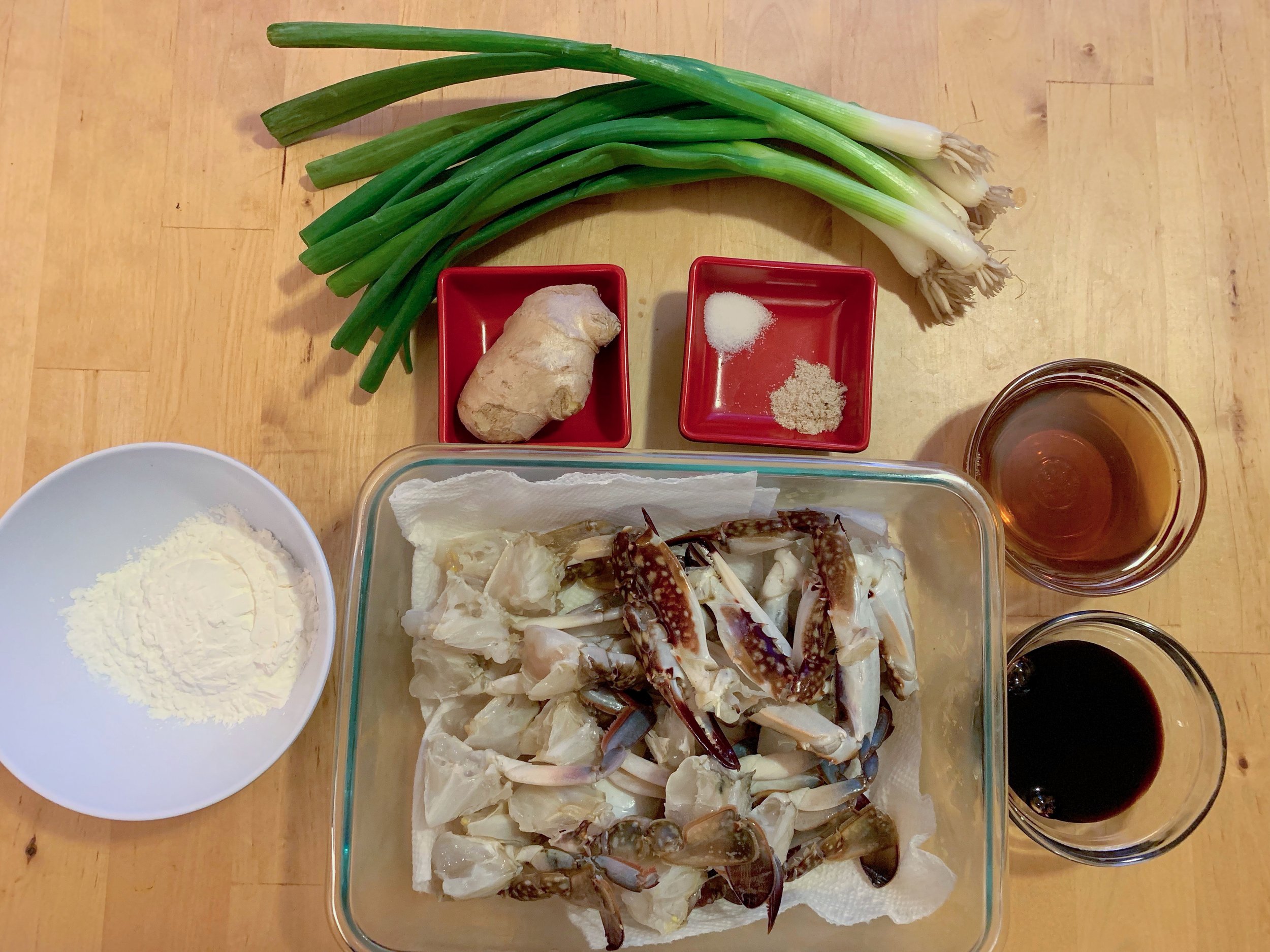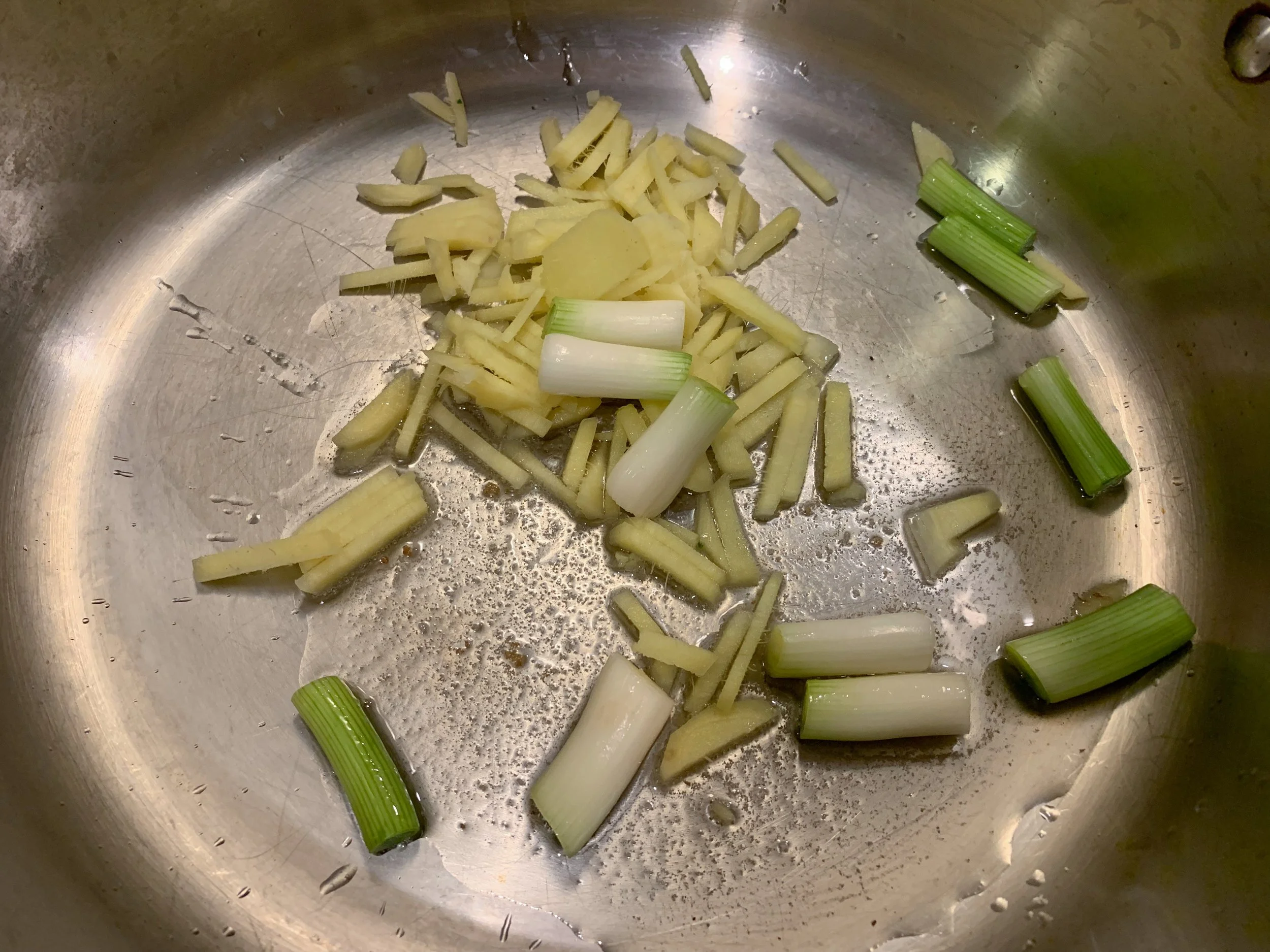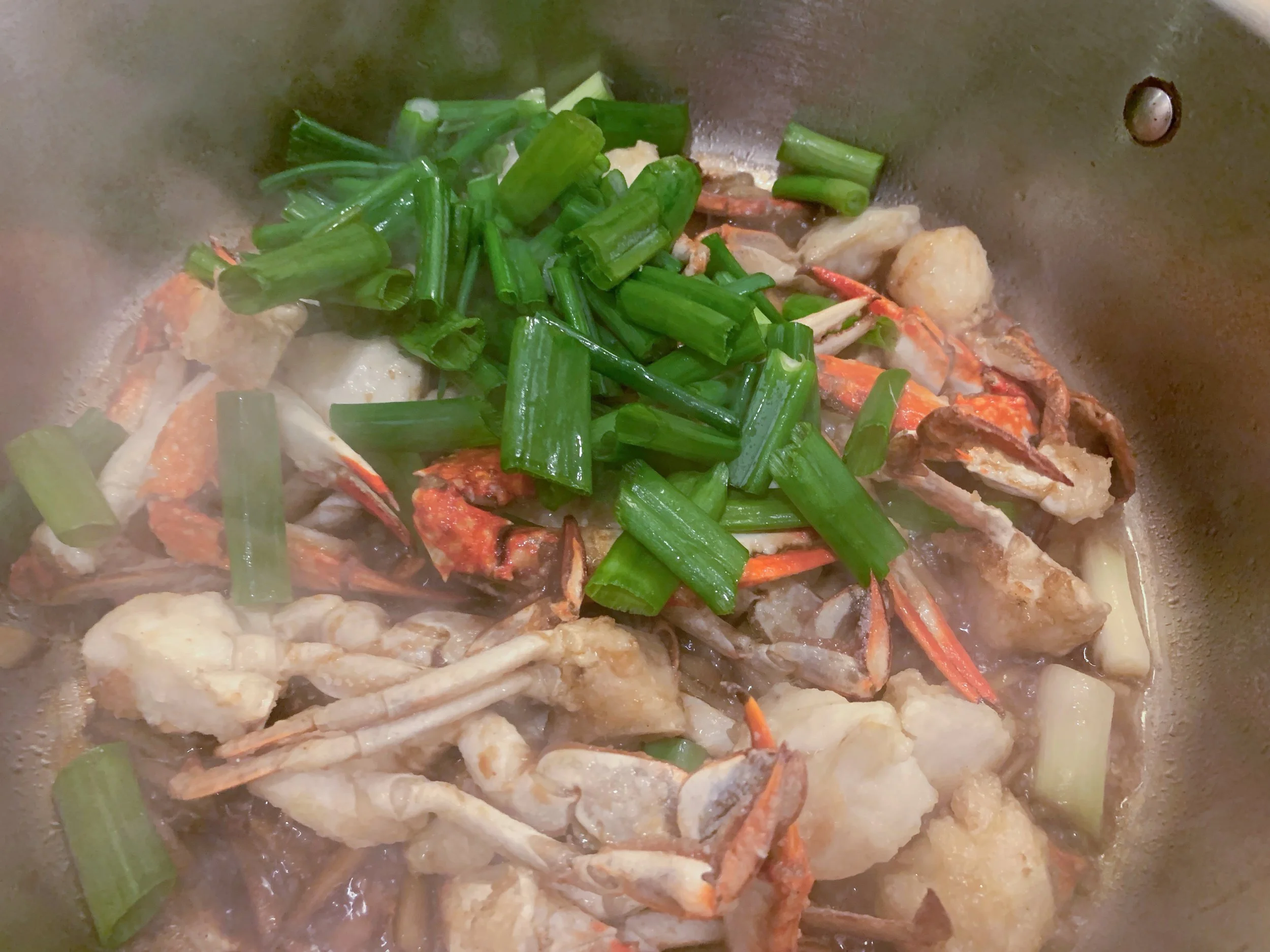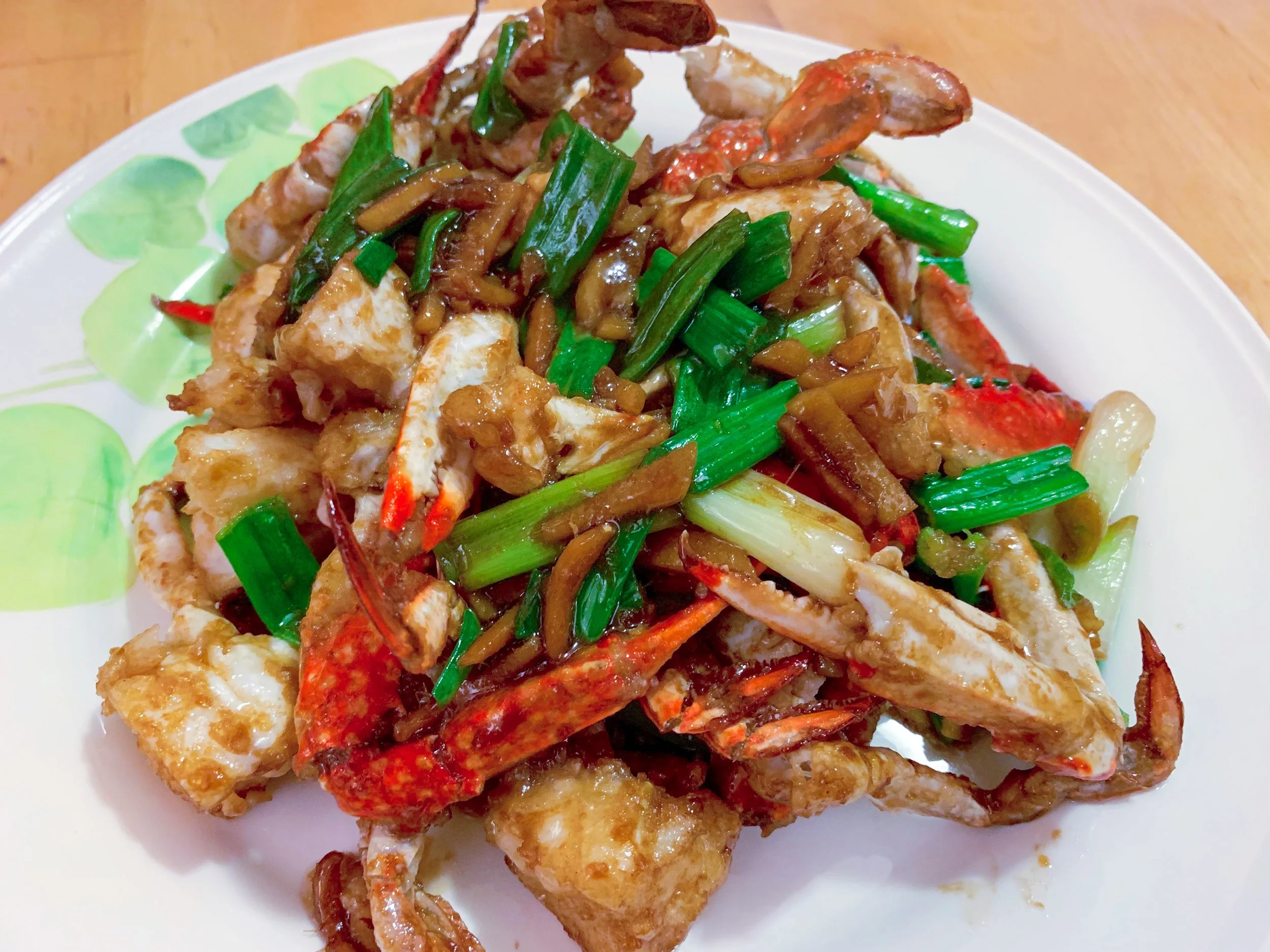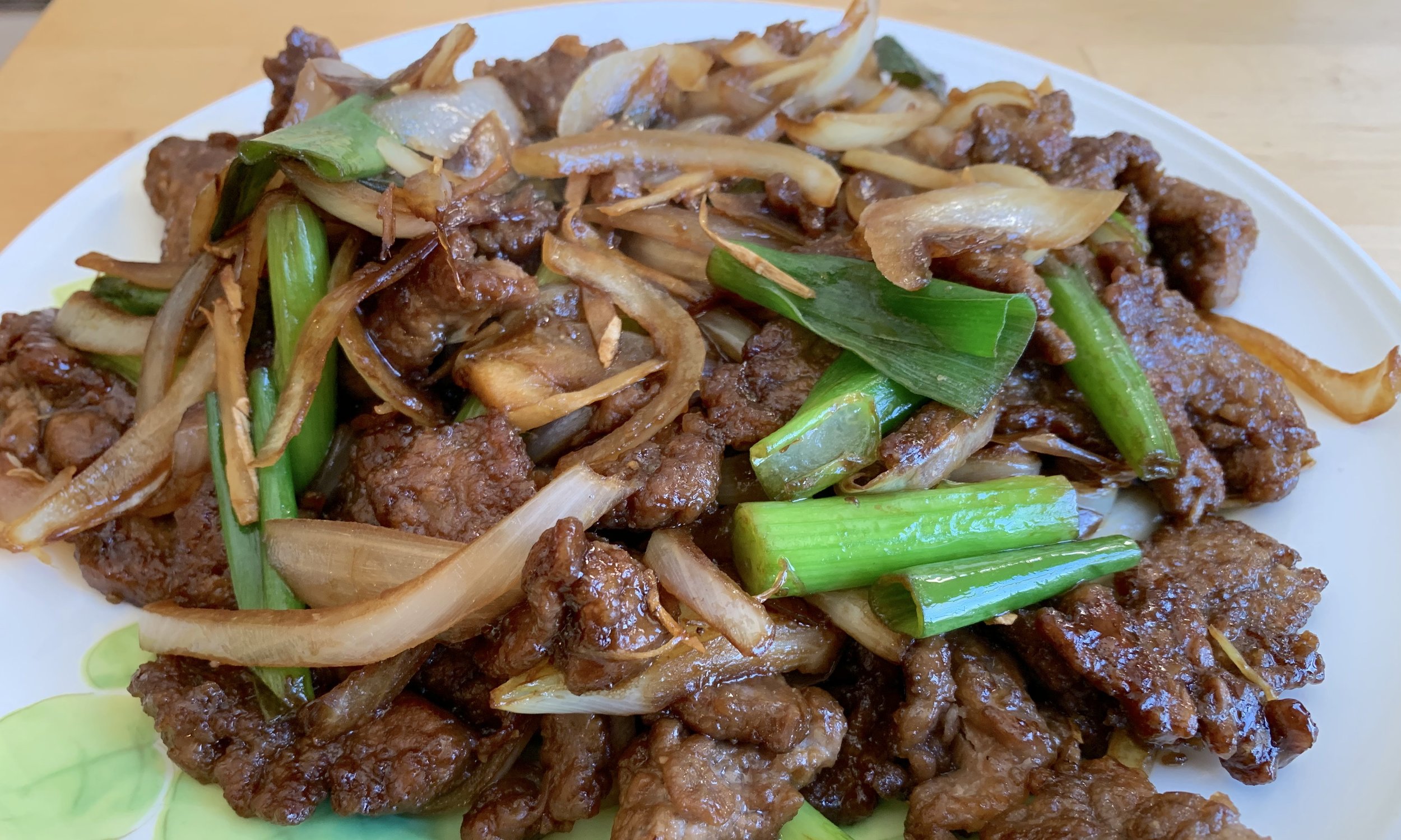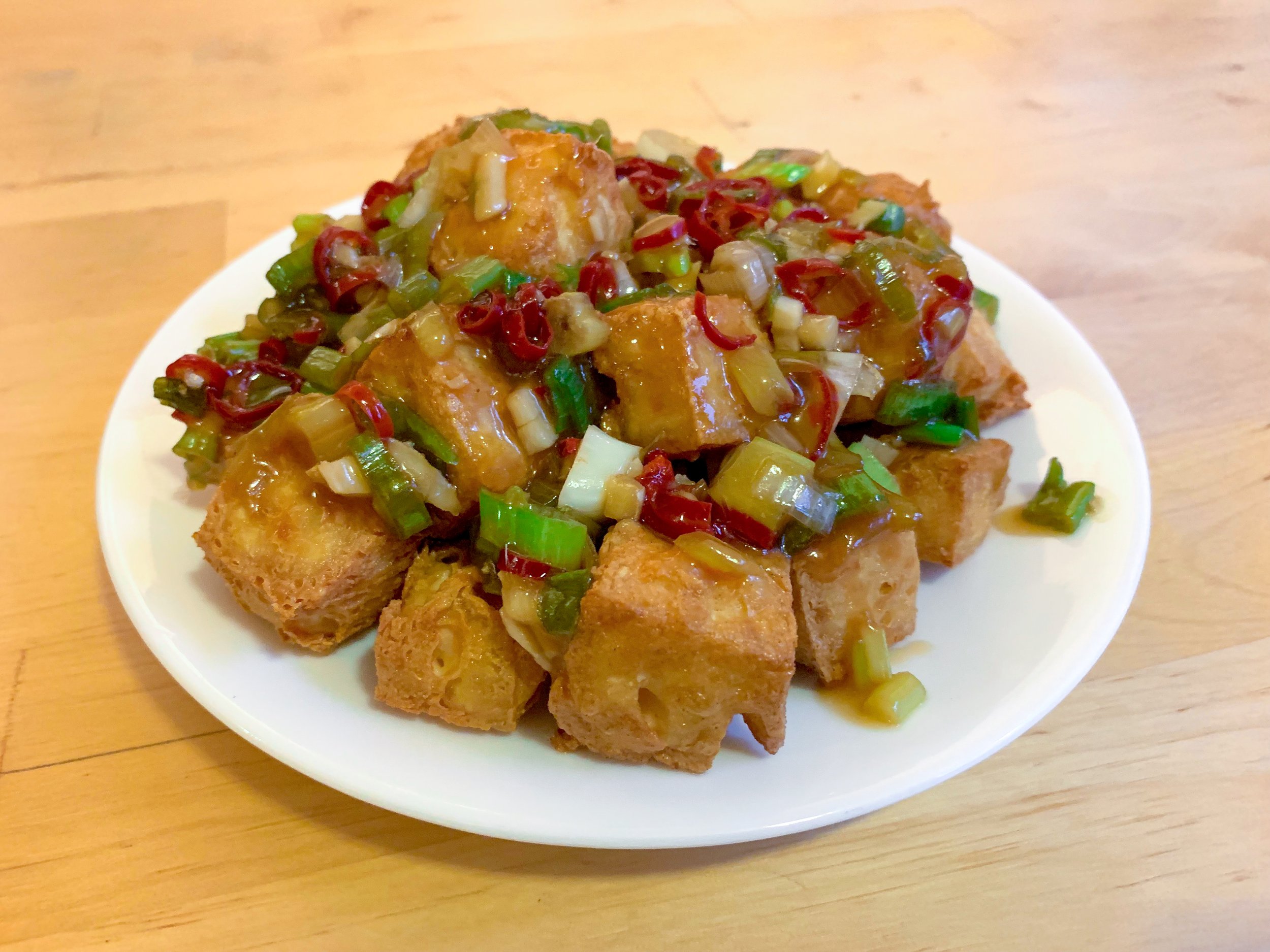Ginger Scallion Crab

姜葱蟹 (Jiang Cong Xie)
Ginger scallion crab is a Cantonese dish from the coast of Southern China, where crabs have been an important part of the local diet for generations. While this dish is traditionally made with mud crab, [1] it can be made with whichever crab is freshest and most readily available in your area. In the United States, Dungeness and blue crabs are popular choices for this dish. Eating ginger scallion crab is a delightfully messy and delicious experience—one you should definitely try at home!
Ingredients
1 lb crab, cleaned and chopped
6 scallions, chopped
2 inch ginger, julienned
3 tbsp cornstarch
3 tbsp Shaoxing rice wine
1 tbsp soy sauce
¼ tsp salt
½ tsp white pepper
Vegetable oil
When cooking crab, first you have to clean it. You can ask your fishmonger to do this for you, or you can do this yourself at home. While the exact procedure can vary between crab species, the basic motions are the same. First, if you are using a live crab, dispatch it either with a 60 second parboil, or with a screwdriver driven into the brain of the crab between the eyes. Then remove the carapace of the crab, and remove the guts and the gills, both of which are inedible.[2]
Once your crab is cleaned, we have to prepare it for the stir fry. Unlike in the West, where crab is often served whole and delivered to the table with dedicated equipment, such as crab crackers and picks, in Chinese cuisine, crab dishes are supposed to be eaten with just chopsticks and fingers. This means that we have to do deal with some of the shelling prior to cooking. Remove the claws of the crab, and the legs as well, if working with a large crab. With a rolling pin or the back of a chef’s knife, strike the crab claws and legs to crack them. These cracks will help the sauce seep into the meat, and make the crabs easy to eat at the table without a crab cracker. Cut the body of the crab into quarters.
After the crab is chopped and cleaned, we will dredge and fry it. At first, it seems like an odd decision to fry shellfish with the shell on. If we’re not going to enjoy a crispy, crunchy, exterior, what’s the point? First, a well-controlled fry is better for retaining moisture in the crab than boiling. Second, many of the flavor compounds in crab shell are fat-soluble, so frying will make the crab meat taste a bit more intensely like crab. Lastly, frying also allows us to develop a thin coating of starch, which will help the sauce cling to the crab pieces.
Prepare the dredge by mixing together 3 tablespoons cornstarch with ¼ teaspoon salt and ½ teaspoon white pepper. Then dredge the crab pieces in the cornstarch mixture, shaking off the excess. Be sure to thoroughly coat all of the exposed crab meat—this will help protect it from direct heat. The shell portions do not have to be as well coated.
In a heavy pot suitable for shallow-frying, heat ½ inch vegetable oil to 350° F. Place the crab pieces into the hot oil, being careful not to crowd the pan (work in batches if necessary). Crab is quite lean, so it can lose its moisture rapidly if overcooked. Once the shells turn bright red and the meat is opaque and flakes easily, you’re done. This should take 2-3 minutes in the oil, depending on the size of the crab pieces. Drain the crab pieces, and set them aside.
Prepare the aromatics by julienning the ginger and chopping the scallions into 2 inch lengths. Place a second pan over medium heat, and add a tablespoon of the crab frying oil to this pan. [3] When the oil comes up to temperature, add the julienned ginger and scallion whites to the pan and fry until fragrant, about 30 seconds. Then turn the heat up to high and add the cooked crab pieces, together with the rice wine, soy sauce, and reserved scallion greens. Toss well and stir-fry for about 2 minutes, until the scallions have wilted and the sauce has reduced by at least half and clings to the crab pieces. Remove from the heat and serve immediately.
Substitutions
Lobster, langoustine, or large prawns can all be cooked using this method and with this sauce. If you prefer a sweeter, thicker sauce, substitute oyster sauce for the soy sauce. If you’d prefer not to shell the crabs at the table, you can substitute the fried crab for ½ a pound of jumbo lump crab meat (but where’s the fun in that?).
[1] The common mud crab (Scylla serrata) is found in the Indian and Pacific Oceans, off the coasts of Africa, South Asia, East Asia, and Oceania, and is one of the most heavily fished species of crab. However, while the adults are found in shallow waters and mangrove forests, the larvae of the species cannot survive in the low-salinity environment of coastal ecosystems. Therefore, the female crabs will migrate far offshore to spawn in the open ocean.
[2] Crab gills are sometimes referred to as “dead man’s fingers.” Despite the name, they aren’t actually poisonous. However, they are tough and indigestible, and will also concentrate any toxins from the crab’s aquatic environment.
[3] This oil is incredibly fragrant, courtesy of the crab shells. If you want to save this oil, you can keep it in the refrigerator for about a week. Use this crab frying oil in applications which could benefit from a strong crab flavor. Some suggestions: fried rice, shrimp stir-fries, or a drizzle over a seafood ramen.
Recipe
Prep Time: 20 min Cook Time: 10 min Total Time: 30 min
Difficulty: 4/5
Heat Sources: 2 burners
Equipment: heavy pot, pan
Servings: 4
Ingredients
1 lb crab, cleaned and chopped
6 scallions, chopped
2 inch ginger, julienned
3 tbsp cornstarch
3 tbsp Shaoxing rice wine
1 tbsp soy sauce
¼ tsp salt
½ tsp white pepper
Vegetable oil
Instructions
1. Clean the crab, cut it into pieces, and crack the shells on the legs and claws.
2. Mix the cornstarch, salt, and white pepper together, and dredge the crab pieces in the seasoned cornstarch.
3. Heat about ½ inch vegetable oil in a heavy pot to 350° F. Fry the crab pieces for about 2-3 minutes, flipping once, until the shells turn bright red and the meat is fully cooked. Work in batches if necessary. Drain the cooked crab pieces from the oil and set aside.
4. Add 1 tbsp of the crab frying oil to a pan over medium heat. Julienne the ginger and cut the scallions into 2 inch lengths. When the oil comes up to temperature, add the julienned ginger and the whites of the scallions to the pan and fry until fragrant, about 30 seconds.
5. Turn the heat up to high, and add the crab pieces to the pan, together with the rice wine, soy sauce, and scallion greens. Stir-fry for about 2 minutes, until the scallions have wilted and the sauce has reduced and thickened. Serve immediately.
